
100 Ohm Resistor: Comprehensive Guide to Color Codes, Applications, and Selection
The 100 ohm resistor is a key component in electronic devices. Due to its frequent use, it is an ideal candidate for understanding the resistor color code, facilitating easy recognition in various projects alongside other commonly employed resistors. The color code associated with the 100 ohm resistor allows for rapid identification of its resistance value and tolerance. This article will assist you in interpreting 4-band, 5-band, and 6-band configurations for 100 ohm resistors.
What is a 100 Ohm Resistor?
Resistors are commonly used in electrical systems, where they are primarily used to regulate the flow of electrical current. These components are typically compact and feature wire leads extending from various directions. Resistors are designed to operate as distinctive elements within circuits, imparting specific electrical resistance values. A resistor rated at 100 ohms is an electrical device used to regulate current, adjust signal levels, and separate voltages. These resistors are constructed from a substance that impedes the flow of electricity, often a carbon-based compound. They play a crucial role in controlling current within electronic circuits and safeguarding other components from potential overload. Moreover, they are used to calibrate electronic components and contribute to voltage division circuits.
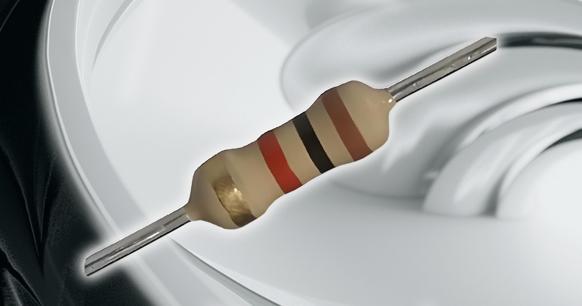
Who Makes a 100 Ohm Resistor?
·
A number of manufacturers, including well-known industry names such as Vishay, Bourns, and Panasonic, produce 100 ohm resistors. These resistors are available in both through-hole and surface mount configurations, with a range of wattage ratings, temperature coefficients, and tolerances to suit diverse customer requirements. The specific manufacturer may also offer 100 ohm resistors with different lead arrangements, such as axial or radial.
When selecting a 100 ohm resistor, it is essential to evaluate key factors such as the temperature coefficient, power rating, and component tolerance. This guarantees that the resistor can efficiently handle the expected current and voltage levels. Furthermore, the resistor's form factor should be taken into account, as it determines the component's size and shape, and thus its compatibility with the designated space on the circuit board. With such a wide range of manufacturers and options on the market, sourcing the ideal 100 ohm resistor for any application is a straightforward process.
100 Ohm Resistor Color Code
It is important to note that not all four bands signify the resistance in Ohms. The first three bands indicate the nominal value of the resistor, which is 100 ohms. The fourth band provides information about the tolerance of the resistor.
It should be noted that every resistor has a tolerance, which means that the actual value may not be 100 ohms. Resistors of superior quality typically demonstrate more precise tolerances.
100 Ohm Resistor Color Bands
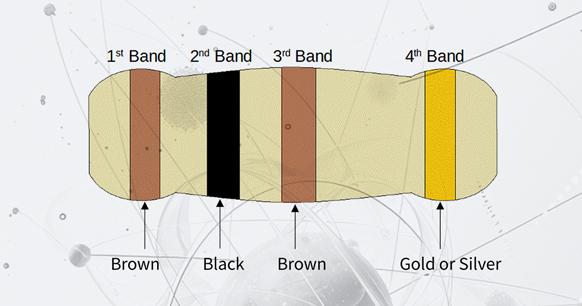
The last band is distinct from the others due to a small gap. This band is typically made of gold or silver and is often the easiest to discern. It reveals the resistor's tolerance.
Once the fourth band has been identified, direct your attention to the bands on the opposing side of the resistor. The initial two bands provide a foundational value, which must be multiplied by the multiplier to ascertain the complete resistance value.
The third band is used as the multiplier. The comprehensive resistor value can be determined by multiplying the value indicated by the first two bands with the multiplier.
Further details on this process can be found in the following sections.
100 Ohm Resistor Color Chart
|
Band Number |
Function |
Color |
Value |
|
1 |
1st Digit |
Brown |
1 |
|
2 |
2nd Digit |
Black |
0 |
|
3 |
Multiplier |
Yellow |
x 10 |
|
4 |
Tolerance |
Gold (or silver) |
± 5% (± 10% for silver) |
|
Total Value: 100 ± 5% Ω |
|||
To ascertain the color code of a 100 ohm resistor, kindly refer to the resistor color chart.The image below illustrates the color code for a 100R 4-band resistor.
The color code for a 100 ohm resistor with four bands is brown, black, brown, and gold.
Calculating the 4-band 100 ohm resistor color code:
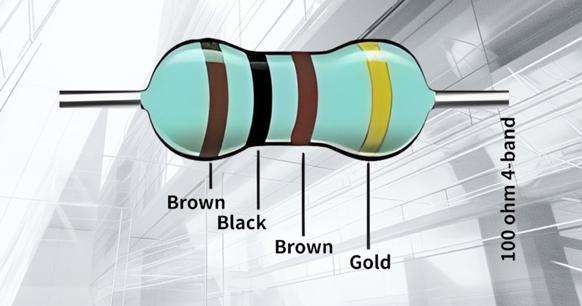
- 1st band = Brown = 1 (1st digit)
- 2nd band = Black = 0 (2nd digit)
- 3rd band = Brown = 1 (multiplier) = 10^1 = 10
- 4th band = Gold = ±5% (tolerance)
Thus, 100 × 1 ± 5% → 100 ohms → 100 Ω
The tolerance is → 5% of 100 → 5 Ω
In theory, the value of a 100 Ω resistor ranges between 95 Ω and 105 Ω.
Description:
Please refer to the chart below for clarification on how to decode the color bands and corresponding decimals. For a 100-ohm resistor, the first digit is "1," so the appropriate color band value is 1, which corresponds to brown. The second digit is '0', therefore the corresponding color is black. The third digit, '0' (but with a value of 10^1 = 10), is the multiplier '1'. Therefore, the appropriate color is brown.
Please note that the last band in 4- and 5-band resistors indicates the tolerance value. In this instance, the gold designation signifies a 5% tolerance. The color silver indicates a 10% tolerance, while brown indicates a 2% tolerance. In the event that the fourth band is not present, it should be assumed to indicate a 20% tolerance.
Illustration depicting the color code for a 100 ohm 5-band resistor:
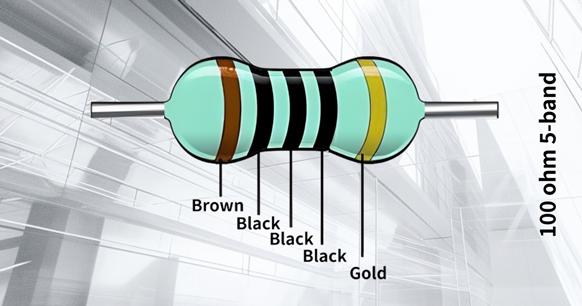
The color code for the 100R 5-band resistor is brown, black, black, black, gold. It is represented as follows:
- 1st band = Brown = 1 (1st digit)
- 2nd band = Black = 0 (2nd digit)
- 3rd band = Black = 0 (3rd digit)
- 4th band = Black = 0 (multiplier) = 10^0 = 1
- 5th band = Gold = ±5% (tolerance)
Description:
For a 100-ohm 5-band resistor,
- The 1st digit is '1', so refer to the chart for the color with the value 1, and that's your 1st color (brown).
- The 2nd digit is '0', so find the color with the value 0, which becomes the 2nd band color (black).
- The 3rd digit is '0', so look for the color with the value 0, which becomes the 3rd band color (black).
- Now, the 4th digit is the multiplier value (10^0 = 1), which is zero; hence, the 4th band will be black.
How to Read the 100 Ohm Resistor Color Code
The color codes typically used for resistors include digits, a multiplier, and a tolerance value. In the case of six-band resistors, a temperature coefficient is also introduced.
We recommend starting with four-band resistors as this is the most straightforward approach. Once you have a firm grasp on the four-band system, understanding the color coding of five- and six-band resistors is relatively straightforward.
Let's review the resistor color code table and the method for determining values:
Resistors are a common component in a variety of circuits and power ratings. The color-coded bands on lower-power resistors convey information about resistance and tolerance, as illustrated in the figures above.
In the case of the 100-ohm resistor illustrated above, the bands are clustered toward one end of the resistor. The color band closest to one end represents the first digit of the value. The subsequent band represents the second digit, the third band represents the third digit (for 5-band resistors), the next band represents the multiplier, and the last band determines the tolerance value.
The associated values for the diverse band colors are detailed:
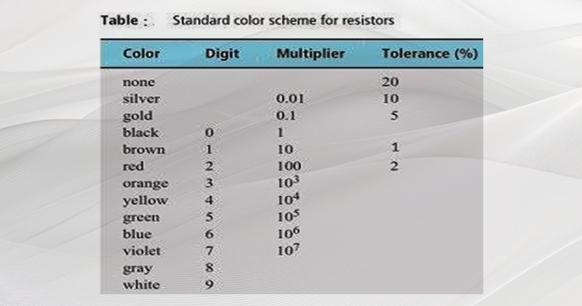
For instance, a resistor with yellow, violet, orange, and gold bands corresponds to a value of 47 × 1000 ± 5% Ohms.
Resistor Sizes
Resistors are available in a variety of configurations, allowing users to adjust their values through different methods. A variable resistor with two pins is referred to as a rheostat. The most prevalent and adaptable type features three pins and is known as a potentiometer, commonly referred to as a "pot."
It is essential to select the appropriate power rating for the resistor in question. The size of a resistor indicates its power rating. Common wattage values include 1/8, 1/4, 1/2, 1, 2, 5 watts, and so on.
The 4 Band 100 Ohm Resistor
Each band on the resistor serves a distinct purpose: The initial digit of the resistance value is represented by the first band, colored brown, which corresponds to the value 1.
Band Two – 2nd Digit: The black second band signifies the second digit of the resistance value, complementing the first digit from band one to produce the digit 10.
Band Three – Multiplier: The combined digits are multiplied by a value determined by the color of this band. The actual multiplier is 10^n, where n is the numerical value assigned to the band color. In this instance, the third band, brown, corresponds to the number 1, resulting in a multiplier of 10^1, or 10.
Therefore, the total resistance value determined by the colors is 10 (from digits) × 10^1 (from multiplier) Ω, which equals 100 Ω.
Band Four – Tolerance: The tolerance value for the resistor is indicated by the use of common values, including 5% (depicted by a gold band) and 10% (represented by a silver band). In this example, using a gold band yields a tolerance of 5%.
Therefore, the overall resistance can be calculated as 100Ω ± 5%. This indicates that the true resistance value may range from 95Ω to 105Ω. If the fourth band is silver, indicating a 10% tolerance, the total resistance is 100Ω ± 10%. In this case, the actual resistance is expected to fall between 90Ω and 100Ω.
A multimeter is an invaluable tool for verifying resistors, offering a reliable method to determine their resistance. It is of the utmost importance to adhere to the established safety guidelines when utilising multimeters. In resistors with six bands, the last band provides information on temperature dependence. Please see below for further details.
One hundred ohm resistors are identified by the color code brown-black-brown-gold, while five-band resistors are distinguished by brown-black-black-black-gold. If you wish to measure the color code of resistors other than the 100 ohm resistor, you will need to follow the appropriate procedure. In such instances, we recommend utilising the Resistor Color Code Calculator, which will assist in accurately and efficiently identifying the color code of resistors.
4-Band vs. 5-Band vs. 6-Band 100 Ohm Resistor Color Code
You may come across resistors with 5 or even 6 bands.
Reading 5- or 6-band resistors is a straightforward process for those already familiar with four-band resistor color coding.
5 Band 10K Resistor Color Code
In the case of 100 Ohm resistors featuring five bands, the initial three bands will be brown, black, and black (signifying 100), while the fourth band will be black, denoting a multiplier of x1.
|
Band Number |
Function |
Color |
Value |
|
1 |
1st Digit |
Brown |
1 |
|
2 |
2nd Digit |
Black |
0 |
|
3 |
3rd DigitBlack |
Black |
0 |
|
4 |
Multiplier |
Black |
x 1 |
|
5 |
Tolerance |
Gold (or silver) |
± 5% (± 10%) |
|
Total Value: 100 ± 5% Ω |
|||
4-Band vs. 5-Band vs. 6-Band 100 Resistor Color Code Table
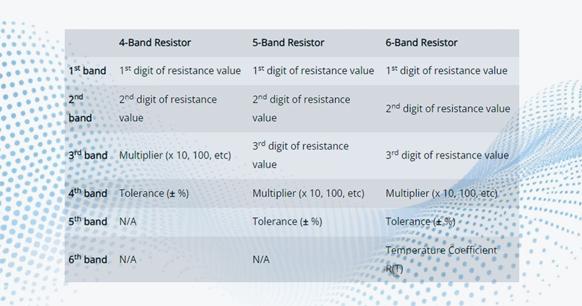
4 Band vs. 5 Band 100 Ohm Resistor
The allocation of bands in resistors with four bands is as follows: two bands for the value, one for the multiplier, and one for the tolerance.
By contrast, five-band resistors incorporate an additional band for the value. Therefore, these resistors feature three bands for the value, one for the multiplier, and one for the tolerance. The process for examining the resistor remains consistent. Begin by examining the fifth band, noting a slight gap between the fourth and fifth bands, and then identifying the tolerance. Subsequently, revert to the initial four bands to determine the resistance value.
For a 100-ohm resistor with five bands, the expected sequence is brown (1), black (0), black (0), black (x1), and gold or silver (± 5% or 10%).
6 Band 100 Ohm Resistor
|
Band Number |
Function |
Color |
Value |
|
1 |
1st Digit |
Brown |
1 |
|
2 |
2nd Digit |
Black |
0 |
|
3 |
3rd DigitBlack |
Black |
0 |
|
4 |
Multiplier |
Black |
x 1 |
|
5 |
Tolerance |
Gold (or silver) |
± 5% |
|
6 |
Temp. Coefficient |
Any |
See Chart Below |
|
Total Value: 100 ± 5% Ω |
|||
Six-band resistors are similar to their five-band counterparts, with the exception of an additional band indicating the temperature coefficient, which is the extent to which resistance will vary with temperature.
In this scenario, the last two bands (the fifth and sixth bands) should be in close proximity, with a discernible gap between the fourth and fifth bands.
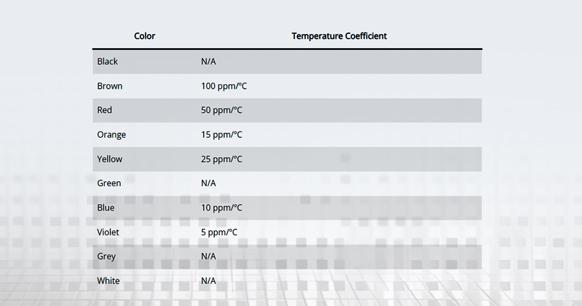
Applications of 100 Ohm Resistor
These 100 ohm resistors are commonly used in breadboards and various prototyping scenarios. They are ideal for use as pull-ups, pull-downs, and current limiters. The robust-lead variants of these resistors are designed to seamlessly integrate into breadboards, exhibiting minimal displacement. Therefore, integrating them into your next project should be straightforward.
Breadboard Prototyping:
In electronic breadboard prototyping, 100 ohm resistors are frequently used due to their adaptability, making them well-suited for a variety of applications within these experimental setups.
Pull-Up Resistors:
These components serve as pull-up resistors, often integrated into circuits to ensure a defined logic level when a signal line is either unconnected or in a high-impedance state. This is essential for maintaining stability in digital circuits.
Pull-Down Resistors:
These resistors serve as pull-down resistors, which are essential for maintaining a predetermined low logic level when a signal line is either unconnected or not actively driven. This is of particular significance in digital circuits, where it is vital to prevent erratic inputs.
Current Limiters:
In a variety of electronic circuits, particularly those with LEDs or other sensitive components, 100 ohm resistors can serve as effective current limiters. Their function is to manage the flow of current, preventing components from drawing excessive current and ensuring proper functionality.

How to Make a 100 Ohm Resistor?
To create a 100 ohm resistor, it is essential to have a fundamental understanding of resistor construction and color coding. The first step is to obtain a resistor with the desired resistance value, which is readily available on the market. The color code for a 100 ohm resistor is brown, black, and brown, with each color corresponding to a specific digit. The brown color denotes the value of 1, the black color signifies the value of 0, and the brown color serves as a multiplier of 10. Please assemble the resistor by linking the leads to the designated points on the resistor body. It is of the utmost importance to maintain precision in the color-coding process, as any deviation may result in an inaccurate resistance value. Once assembled, the 100-ohm resistor can be seamlessly integrated into electronic circuits, effectively regulating current flow and voltage levels.
An alternative method is to wind a length of slender nichrome wire around a ceramic insulator. As an alternative, you may wish to consider acquiring an adjustable pre-wound resistor, which can be configured to achieve 100 ohms. The process typically begins with a resistive material with a known resistivity, such as carbon composition or metal film.
Final Words
It is important to consider various factors when selecting a 100 ohm resistor for a specific application. Key considerations include the wattage rating, tolerance, and temperature coefficient. The wattage rating indicates the maximum power the resistor can handle without overheating, while the tolerance specifies the maximum permissible variation in resistance over time. The temperature coefficient indicates the extent of resistance variation with temperature, which is a significant consideration in applications exposed to extreme temperature conditions.
In general, 100 ohm resistors are versatile components applicable across diverse scenarios. They are cost-effective, readily available, and come in a broad spectrum of wattage ratings, tolerances, and temperature coefficients.




